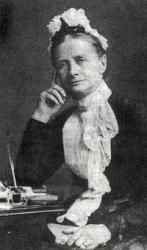Scripture References:
st. 1-2 = Luke 2:4-7
st. 4 = Mark 10:14
st. 5 = Rom. 8:34
To help children understand the Apostles' Creed words "who was conceived by the Holy Spirit, born of the virgin Mary," Cecil F. Alexander (b. Redcross, County Wicklow, Ireland, 1818; Londonderry, Ireland, 1895) wrote this text and published it in her Hymns for Little Children (1848). Five of her six stanzas are included; the third stanza is omitted.
A good mingling of the biblical story and Christian theology, the text sets the nativity of Christ into a much larger framework-the history of salvation. Alexander's words enable us to look back and to look forward from this historic event. Stanzas 1 and 2 recall Christ's humble birth. Stanza 3 focuses on Christ's childhood and identity with humanity. Stanzas 4 and 5 look forward to the sharing of Christ's glory with his children.
As a small girl, Cecil Frances Humphries wrote poetry in her school's journal. In 1850 she married Rev. William Alexander, who later became the Anglican primate (chief bishop) of Ireland. She showed her concern for disadvantaged people by traveling many miles each day to visit the sick and the poor, providing food, warm clothes, and medical supplies. She and her sister also founded a school for the deaf. Alexander was strongly influenced by the Oxford Movement and by John Keble's Christian Year. Her first book of poetry, Verses for Seasons, was a "Christian Year" for children. She wrote hymns based on the Apostles' Creed, baptism, the Lord's Supper, the Ten Commandments, and prayer, writing in simple language for children. Her more than four hundred hymn texts were published in Verses from the Holy Scripture ( 1846), Hymns for Little Children (1848), and Hymns Descriptive and Devotional (1858).
Liturgical Use:
Christmas Eve or Christmas Day worship services, especially as a glorious processional; anytime during the church year in conjunction with worship services in which this part of the creed or eschatological themes (st. 5) is preached; church school programs.
--Psalter Hymnal Handbook
======================
Once in Royal David's city. C. F. Alexander, née Humphreys. [Christmas.] First appeared in her Hymns for Little Children, in 1848, p. 30. It is based on the words of the Creed, "Who was conceived by the Holy Ghost, Born of the Virgin Mary," and is in 6 stanzas of 6 lines. It is usually given in a correct form, and ranks as one of the most popular of Mrs. Alexander's hymns for children.
--John Julian, Dictionary of Hymnology (1907)
Notes
Scripture References:
st. 1-2 = Luke 2:4-7
st. 4 = Mark 10:14
st. 5 = Rom. 8:34
To help children understand the Apostles' Creed words "who was conceived by the Holy Spirit, born of the virgin Mary," Cecil F. Alexander (b. Redcross, County Wicklow, Ireland, 1818; Londonderry, Ireland, 1895) wrote this text and published it in her Hymns for Little Children (1848). Five of her six stanzas are included; the third stanza is omitted.
A good mingling of the biblical story and Christian theology, the text sets the nativity of Christ into a much larger framework-the history of salvation. Alexander's words enable us to look back and to look forward from this historic event. Stanzas 1 and 2 recall Christ's humble birth. Stanza 3 focuses on Christ's childhood and identity with humanity. Stanzas 4 and 5 look forward to the sharing of Christ's glory with his children.
As a small girl, Cecil Frances Humphries wrote poetry in her school's journal. In 1850 she married Rev. William Alexander, who later became the Anglican primate (chief bishop) of Ireland. She showed her concern for disadvantaged people by traveling many miles each day to visit the sick and the poor, providing food, warm clothes, and medical supplies. She and her sister also founded a school for the deaf. Alexander was strongly influenced by the Oxford Movement and by John Keble's Christian Year. Her first book of poetry, Verses for Seasons, was a "Christian Year" for children. She wrote hymns based on the Apostles' Creed, baptism, the Lord's Supper, the Ten Commandments, and prayer, writing in simple language for children. Her more than four hundred hymn texts were published in Verses from the Holy Scripture ( 1846), Hymns for Little Children (1848), and Hymns Descriptive and Devotional (1858).
Liturgical Use:
Christmas Eve or Christmas Day worship services, especially as a glorious processional; anytime during the church year in conjunction with worship services in which this part of the creed or eschatological themes (st. 5) is preached; church school programs.
--Psalter Hymnal Handbook
======================
Once in Royal David's city. C. F. Alexander, née Humphreys. [Christmas.] First appeared in her Hymns for Little Children, in 1848, p. 30. It is based on the words of the Creed, "Who was conceived by the Holy Ghost, Born of the Virgin Mary," and is in 6 stanzas of 6 lines. It is usually given in a correct form, and ranks as one of the most popular of Mrs. Alexander's hymns for children.
--John Julian, Dictionary of Hymnology (1907)
Hymnary Pro Subscribers
Access
an additional article
on the Canterbury Dictionary of Hymnology:
Hymnary Pro subscribers have full access to the Canterbury Dictionary of Hymnology.
Subscribe now


 My Starred Hymns
My Starred Hymns








